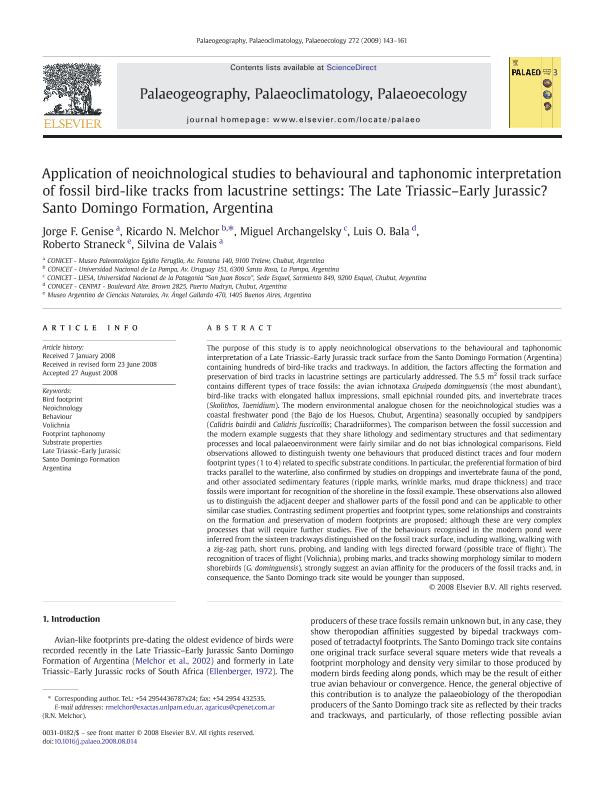Mostrar el registro sencillo del ítem
dc.contributor.author
Genise, Jorge Fernando

dc.contributor.author
Melchor, Ricardo Nestor

dc.contributor.author
Archangelsky, Miguel

dc.contributor.author
Bala, Luis Oscar

dc.contributor.author
Straneck, Roberto Juan

dc.contributor.author
de Valais, Silvina

dc.date.available
2019-09-05T19:44:04Z
dc.date.issued
2009-02
dc.identifier.citation
Genise, Jorge Fernando; Melchor, Ricardo Nestor; Archangelsky, Miguel; Bala, Luis Oscar; Straneck, Roberto Juan; et al.; Application of neoichnological studies to behavioural and taphonomic interpretation of fossil bird-like tracks from lacustrine settings: The Late Triassic-Early Jurassic? Santo Domingo Formation, Argentina; Elsevier Science; Palaeogeography, Palaeoclimatology, Palaeoecology; 272; 3-4; 2-2009; 143-161
dc.identifier.issn
0031-0182
dc.identifier.uri
http://hdl.handle.net/11336/82986
dc.description.abstract
The purpose of this study is to apply neoichnological observations to the behavioural and taphonomic interpretation of a Late Triassic-Early Jurassic track surface from the Santo Domingo Formation (Argentina) containing hundreds of bird-like tracks and trackways. In addition, the factors affecting the formation and preservation of bird tracks in lacustrine settings are particularly addressed. The 5.5 m2 fossil track surface contains different types of trace fossils: the avian ichnotaxa Gruipeda dominguensis (the most abundant), bird-like tracks with elongated hallux impressions, small epichnial rounded pits, and invertebrate traces (Skolithos, Taenidium). The modern environmental analogue chosen for the neoichnological studies was a coastal freshwater pond (the Bajo de los Huesos, Chubut, Argentina) seasonally occupied by sandpipers (Calidris bairdii and Calidris fuscicollis; Charadriiformes). The comparison between the fossil succession and the modern example suggests that they share lithology and sedimentary structures and that sedimentary processes and local palaeoenvironment were fairly similar and do not bias ichnological comparisons. Field observations allowed to distinguish twenty one behaviours that produced distinct traces and four modern footprint types (1 to 4) related to specific substrate conditions. In particular, the preferential formation of bird tracks parallel to the waterline, also confirmed by studies on droppings and invertebrate fauna of the pond, and other associated sedimentary features (ripple marks, wrinkle marks, mud drape thickness) and trace fossils were important for recognition of the shoreline in the fossil example. These observations also allowed us to distinguish the adjacent deeper and shallower parts of the fossil pond and can be applicable to other similar case studies. Contrasting sediment properties and footprint types, some relationships and constraints on the formation and preservation of modern footprints are proposed; although these are very complex processes that will require further studies. Five of the behaviours recognised in the modern pond were inferred from the sixteen trackways distinguished on the fossil track surface, including walking, walking with a zig-zag path, short runs, probing, and landing with legs directed forward (possible trace of flight). The recognition of traces of flight (Volichnia), probing marks, and tracks showing morphology similar to modern shorebirds (G. dominguensis), strongly suggest an avian affinity for the producers of the fossil tracks and, in consequence, the Santo Domingo track site would be younger than supposed.
dc.format
application/pdf
dc.language.iso
eng
dc.publisher
Elsevier Science

dc.rights
info:eu-repo/semantics/openAccess
dc.rights.uri
https://creativecommons.org/licenses/by-nc-sa/2.5/ar/
dc.subject
Argentina
dc.subject
Behaviour
dc.subject
Bird Footprint
dc.subject
Footprint Taphonomy
dc.subject
Late Triassic-Early Jurassic
dc.subject
Neoichnology
dc.subject
Santo Domingo Formation
dc.subject
Substrate Properties
dc.subject
Volichnia
dc.subject.classification
Paleontología

dc.subject.classification
Ciencias de la Tierra y relacionadas con el Medio Ambiente

dc.subject.classification
CIENCIAS NATURALES Y EXACTAS

dc.title
Application of neoichnological studies to behavioural and taphonomic interpretation of fossil bird-like tracks from lacustrine settings: The Late Triassic-Early Jurassic? Santo Domingo Formation, Argentina
dc.type
info:eu-repo/semantics/article
dc.type
info:ar-repo/semantics/artículo
dc.type
info:eu-repo/semantics/publishedVersion
dc.date.updated
2019-08-14T20:13:06Z
dc.journal.volume
272
dc.journal.number
3-4
dc.journal.pagination
143-161
dc.journal.pais
Países Bajos

dc.journal.ciudad
Amsterdam
dc.description.fil
Fil: Genise, Jorge Fernando. Consejo Nacional de Investigaciones Científicas y Técnicas; Argentina. Museo Paleontológico Egidio Feruglio; Argentina
dc.description.fil
Fil: Melchor, Ricardo Nestor. Consejo Nacional de Investigaciones Científicas y Técnicas; Argentina. Universidad Nacional de La Pampa; Argentina
dc.description.fil
Fil: Archangelsky, Miguel. Consejo Nacional de Investigaciones Científicas y Técnicas; Argentina. Universidad Nacional de la Patagonia "San Juan Bosco"; Argentina
dc.description.fil
Fil: Bala, Luis Oscar. Consejo Nacional de Investigaciones Científicas y Técnicas. Centro Científico Tecnológico Conicet - Centro Nacional Patagónico; Argentina
dc.description.fil
Fil: Straneck, Roberto Juan. Consejo Nacional de Investigaciones Científicas y Técnicas. Oficina de Coordinación Administrativa Parque Centenario. Museo Argentino de Ciencias Naturales “Bernardino Rivadavia”; Argentina
dc.description.fil
Fil: de Valais, Silvina. Consejo Nacional de Investigaciones Científicas y Técnicas; Argentina. Museo Paleontológico Egidio Feruglio; Argentina
dc.journal.title
Palaeogeography, Palaeoclimatology, Palaeoecology

dc.relation.alternativeid
info:eu-repo/semantics/altIdentifier/url/https://www.sciencedirect.com/science/article/pii/S0031018208005051
dc.relation.alternativeid
info:eu-repo/semantics/altIdentifier/doi/https://doi.org/10.1016/j.palaeo.2008.08.014
Archivos asociados
